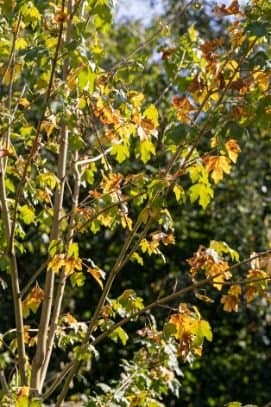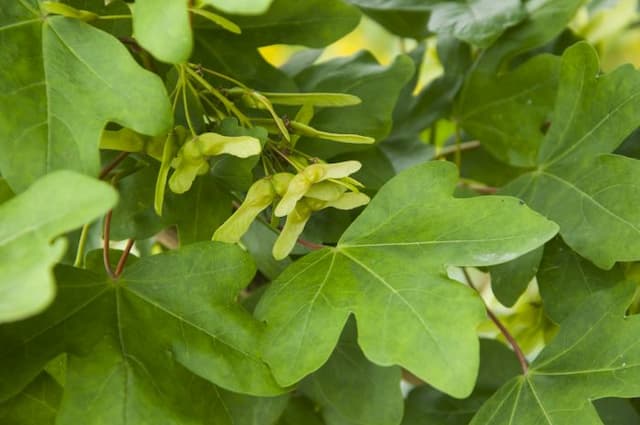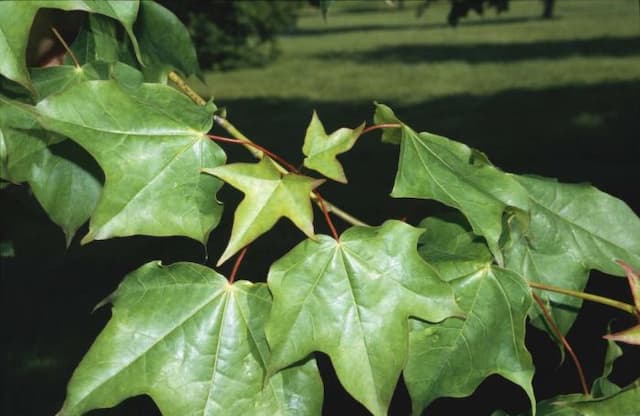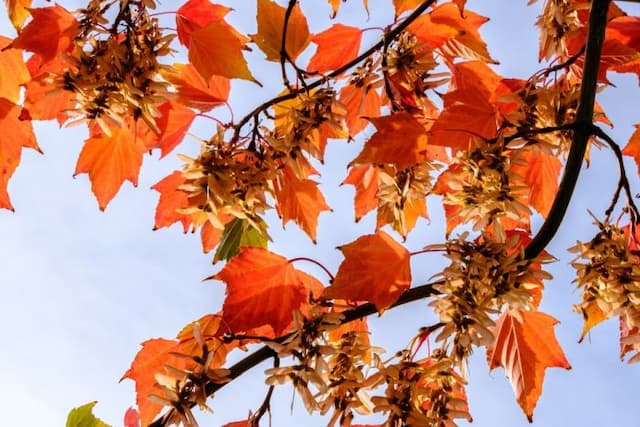Amur Maple Acer tataricum subsp. ginnala
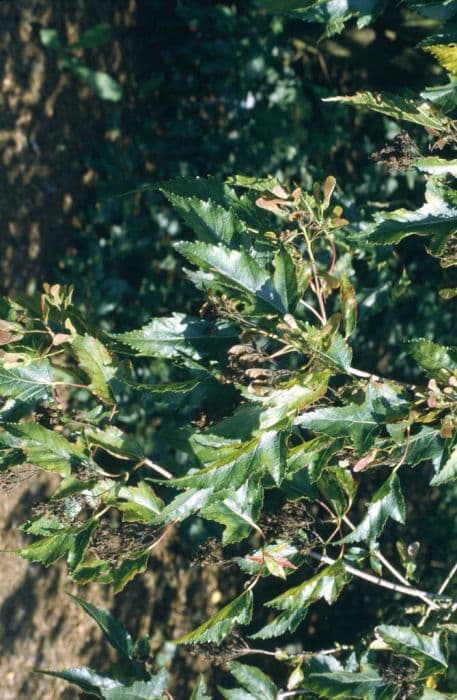
ABOUT
The plant commonly known as Amur maple is a deciduous shrub or small tree that is noted for its graceful foliage and vibrant autumn colors. The leaves are arranged opposite each other on the branches and typically have three lobes, giving them a somewhat triangular appearance reminiscent of the classic maple leaf shape. The leaf margins are finely toothed, and the surface of each leaf is smooth. During the growing season, the foliage is a rich green, turning to striking shades of red and orange in the fall, creating a spectacular display. In spring, small clusters of fragrant, pale yellow to creamy white flowers bloom, adding a subtle beauty and attracting pollinators. Following the blooming period, the plant produces winged seeds, similar to those of other maple varieties, which are commonly referred to as samaras. These seeds are initially green and turn to a tan or brown as they mature in late summer or early fall, persisting on the plant and providing visual interest even after the leaves drop. The bark of the Amur maple is smooth and light gray when young, becoming slightly rough and darker as the plant ages. This plant is versatile and popular in landscaping because of its attractive appearance and seasonal color changes.
About this plant
 Names
NamesSynonyms
Amur Maple, Siberian Maple, Ginnala Maple.
Common names
Acer ginnala, Acer tataricum var. ginnala.
 Toxicity
ToxicityTo humans
Amur maple is not generally considered to be a toxic plant to humans. There are no well-documented cases of poisoning from this plant in scientific literature. However, it is always recommended to be cautious and avoid ingesting parts of ornamental plants as their effects can be unpredictable and they are not intended for consumption.
To pets
Amur maple is also not known to be toxic to pets. There have been no significant reports of pet poisoning from ingestion of this plant. As with humans, it is still wise to prevent pets from eating ornamental plants to avoid any potential health issues or gastrointestinal discomfort that might arise from ingesting plant material that is not part of their normal diet.
 Characteristics
CharacteristicsLife cycle
Perennials
Foliage type
Deciduous
Color of leaves
Green
Flower color
Yellow
Height
15-20 feet (4.5-6 meters)
Spread
15-20 feet (4.5-6 meters)
Plant type
Tree
Hardiness zones
3
Native area
Asia
Benefits
 General Benefits
General Benefits- Ornamental Value: Amur maple displays attractive fall foliage with colors ranging from yellow to vibrant red, enhancing the aesthetics of landscapes.
- Shade Provider: Its dense canopy offers a pleasant shade in gardens and parks, making it an ideal choice for outdoor seating areas.
- Erosion Control: The root system of the Amur maple helps stabilize the soil, reducing the risk of erosion on slopes and banks.
- Wildlife Habitat: It provides shelter and food in the form of seeds for various birds and small mammals.
- Adaptability: Amur maple is tolerant of a range of soil types, urban conditions, and weather patterns, making it a resilient choice for many environments.
- Compact Size: Due to its relatively small size, it is suitable for planting in confined spaces where larger trees would not fit.
- Windbreak: When planted in rows, the Amur maple can act as a windbreak, protecting areas from strong winds.
 Medical Properties
Medical PropertiesThis plant is not used for medical purposes.
 Air-purifying Qualities
Air-purifying QualitiesThis plant is not specifically known for air purifying qualities.
 Other Uses
Other Uses- Acer tataricum subsp. ginnala, commonly known as Amur maple, can be utilized for bonsai due to its small leaves and fine branch structure, making it an ideal candidate for this intricate art form.
- The wood of the Amur maple can be used for woodworking projects, such as crafting small items like boxes or decorative wooden accents, because it has an attractive grain when polished.
- Amur maple's vivid autumn foliage makes it a great candidate for use in fall-themed decorations, such as wreaths and table centerpieces.
- The dried leaves of the Amur maple can be crushed and used as a natural dye to impart a tan or light brown color to fabrics or crafts.
- Its dense foliage provides shelter and nesting opportunities for birds, thus aiding in supporting local bird populations and biodiversity.
- Amur maple can be used as a hedge plant, with its ability to grow densely and be pruned effectively, it serves as a natural privacy screen.
- The tree also serves as a windbreak when planted in rows, especially on the edges of agricultural fields or properties.
- The winged seeds, known as samaras, can be incorporated into craft projects, especially those directed at children, such as creating small, spinning 'helicopters' or ornaments.
- Amur maple is suitable for urban forestry projects and street tree plantings due to its relatively small size and tolerance of varied conditions, including pollution.
- The relatively fast growth rate of Amur maple can be harnessed for use in reforestation and afforestation efforts, especially in temperate zones.
Interesting Facts
 Feng Shui
Feng ShuiThe Amur maple is not used in Feng Shui practice.
 Zodiac Sign Compitability
Zodiac Sign CompitabilityThe Amur maple is not used in astrology practice.
 Plant Symbolism
Plant Symbolism- Change and Adaptation: The Amur maple, with its ability to change colors with the seasons, represents the concept of change and adapting to new conditions.
- Strength and Endurance: As a hardy species that can withstand diverse climates, the Amur maple symbolizes resilience and the ability to endure challenges.
- Growth and Renewal: The plant's growth cycle from seed to tree is emblematic of personal growth and the cycle of renewal and rejuvenation.
 Water
WaterAmur maple should be watered thoroughly, allowing the soil to become slightly dry between waterings. For smaller trees or newly planted specimens, provide about 15-20 gallons of water per week, especially during the growing season and dry spells. Mature trees will require more water but less frequently; roughly 30-40 gallons every two weeks should suffice, ensuring deep soil penetration but avoiding waterlogged conditions.
 Light
LightAmur maple thrives in full sun to partial shade. The ideal location provides direct sunlight for at least six hours a day, but the tree can also perform well in spots with dappled light or light afternoon shade. Avoid deep shade as it may hinder the growth and reduce the vibrancy of the fall foliage.
 Temperature
TemperatureAmur maple is hardy and can tolerate a wide range of temperatures. It can survive winter cold down to -30°F and can handle summer heat up to 90°F. The ideal temperature range for optimal growth is between 60°F and 80°F.
 Pruning
PruningPrune Amur maple to maintain its shape and health, remove any dead or diseased branches, and encourage air circulation. The best time for pruning is late winter or early spring before new growth starts. Pruning should be done annually or as required to keep the tree's form.
 Cleaning
CleaningAs needed
 Soil
SoilAmur Maple thrives in well-draining soil with a pH ranging from 5.5 to 7.5. The ideal soil mix for Amur Maple could be a blend of loamy soil, compost, and coarse sand, which ensures proper drainage and fertility. Ensure the soil mixture is loose and allows for root growth and air circulation.
 Repotting
RepottingAmur Maple, being a relatively slow-growing tree, does not need frequent repotting. If grown in containers, repotting every 3 to 5 years should suffice, using the opportunity to provide fresh soil and to prune the roots gently if necessary.
 Humidity & Misting
Humidity & MistingAmur Maple prefers average to low humidity levels and is quite adaptable to humidity variations. It will thrive in outdoor conditions where the humidity mirrors the natural environment, without the need for any special humidity adjustments.
 Suitable locations
Suitable locationsIndoor
Amur Maple requires bright light and space indoors.
Outdoor
Plant in well-draining soil; full sun to partial shade.
Hardiness zone
3-8 USDA
 Life cycle
Life cycleAcer tataricum subsp. ginnala, commonly known as Amur maple, begins its life cycle as a seed that germinates in spring, with stratification enhancing germination rates. Upon sprouting, the seedling goes through a juvenile phase, developing roots and leaves while relying on stored energy in the seed. As the seedling matures into a sapling, it undergoes primary growth, elongating its stems and expanding its root system while producing distinctive palmate leaves. Secondary growth in ensuing years adds girth to the stems and branches, leading to the development of a woody structure. The Amur maple typically reaches reproductive maturity within a few years, when it starts to flower annually in spring, with the flowers giving way to samaras (winged seeds) that disperse in late summer or fall. The plant can live for several decades, during which it progresses through repeated cycles of growth, flowering, and seed production, before eventually senescing and dying.
 Propogation
PropogationPropogation time
Spring-early summer
The most popular method for propagating Acer tataricum subsp. ginnala, commonly known as Amur maple, is through seed collection and sowing. Propagation is best done in the fall after the samaras have fully ripened and dried. Collect the samaras, which are the winged seeds of the tree, and sow them directly into the soil or stratify them in moist sand at 41 degrees Fahrenheit (5 degrees Celsius) for 90-120 days to break dormancy. Once stratified, the seeds can then be sown in a well-drained seed starting mix in pots or directly outdoors where the maple is intended to grow. As the seedlings emerge and grow, they may be transplanted to their final location in the garden or landscape. The first few years are critical as the young maples establish themselves, but once settled, they can grow into hardy, attractive trees.
